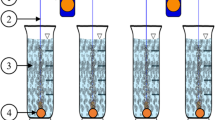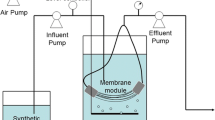Abstract
The present study aimed to overcome the toxicity of the heavy metals load, discharged with the industrial effluents into Alexandria sewerage network, on the activated sludge treatment system through effective acclimation for organic matter and heavy metals removal. Optimization and/or acclimatization of the activated sludge process in the presence of Cu, Cd, Co and Cr contaminating mixed domestic-industrial wastewater was investigated. Acclimatization process was performed through abrupt and stepwise addition of tested metals using sequencing batch reactors treatment approach and evaluated as microbial oxygen uptake rate (OUR), dehydrogenase activity (DHA), organic matter (COD) and heavy metals removal. Abrupt addition of metals adversely affected sludge bioactivity leading to decline in the removal efficiency of the targeted contaminants and loss of floc structure. Metals IC50 confirmed that copper possessed the highest toxicity towards the OUR, DHA activity and COD removal with orders Cu > Cd > Cr > Co; Cu > Cd > Co = Cr and Cu > Cd > Cr > Co, respectively. The highest metal removal was recorded for Cd followed by Co, Cu and finally Cr, most of which was retained in the dissolved influent. However, controlled stepwise application of the tested metals exhibited high sensitivity of DHA and OUR activities only at the highest metal concentrations although enhanced at the lowest concentrations while COD removal was not significantly affected. In conclusion, this approach resulted in adaptation of the system where sludge microbes acquired and developed natural resistance to such metals leading to remarkable enhancement of both organic matter and heavy metals removal.






Similar content being viewed by others
References
Anderson K, Koopman B, Bitton G (1988) Evaluation of INT-dehydrogenase assay for heavy metal inhibition of activated sludge. Water Res 22(3):349–353
Aoyama M, Nagumo T (1997) Effects of heavy metal accumulation in apple orchard soils on microbial biomass and activities. Soil Sci Plant Nutr 43:821–831
Arican B, Yetis U (2003) Nickel sorption by acclimatized activated sludge culture. Water Res 37:3508–3516
Borowski K (2004) An operations overview and practical guide of microwave lab station. Inc Milestone, Suginami
Bruins MR, Kapil S, Oehme FW (2000) Microbial resistance to metals in the environment. Ecotoxicol Environ Safety 45:198–207
Chen BY, Wu CH, Chang JS (2006) An assessment of the toxicity of metals to Pseudomonas aeruginosa PU21 (Rip64). Bioresour Technol 97(15):1880–1886
Clesceri LS, Greenberg CG, Eaton AD (1999) Standard method for the examination of water and wastewater, 20th edn. American Public Health Association (APHA), USA ISBN 0-87553-235-7
Coello MD, Marquez DS, Alonso JMQ (2002) Toxic effects of metals on microbial activity in activated sludge process. Chem Biochem Eng Q 17(3):139–144
Cokgor EU, Ozdemir S, Karahan O, Insel G, Orhon D (2007) Critical appraisal of respirometric methods for metal inhibition on activated sludge. J Hazard Mat B 139:332–339
Costley C, Wallis FM (2001) Bioremediation of heavy metals in a synthetic wastewater using a rotating biological contactor. Water Res 35(15):3715–3723
Dalzell DJB, Christofi N (2002) An ATP luminescence method for direct toxicity assessment of pollutants impacting on the activated sludge process. Water Res 36:1493–1502
Dalzell DJB, Alte S, Aspichueta E, Sota ADL, Etxebarria J, Gutierrez M, Hoffmann CC, Sales D, Obst U, Christofi N (2002) A comparison of five rapid direct toxicity assessment methods to determine toxicity of pollutants to activated sludge. Chemosphere 47:535–545
El-Bestawy E (2000) Selective bioaccumulation of a combination of heavy metals by a range of brackish water bacteria. Pak J Biol Sci 3(9):1496–1499
El-Bestawy E (2008) Treatment of mixed domestic-industrial wastewater using cyanobacteria. J Ind Microbiol Biotechnol 35(10):1503–1516. doi:10.1007/s10295-008-0452-4
El-Bestawy E, Hassouna MS, Abd El-Fattah HI, Abou El-Kheir E (1998) Enhancement of bacterial efficiency for metal removal using mutation techniques. World J Microbiol Biotechnol 14(6):853–856
El-Bestawy E, El-Masry MH, El-Koweidy AH (1999) Removing chromium from tannery wastewater effluent using bench sand biofilm filter. In: Proceeding of the international conference on environmental management, Health and Sustainable Development, 22–25 March, Alexandria
El-Bestawy E, Hassouna MS, El-Masry MH, Abou El-Kheir E (2000) b) Bioaccumulation enhancement of heavy metals by mutant bacteria. Al-Azhar J Microbiol 47:135–151
El-Bestawy E, Hussein H, Baghdadi HH, El-Saka M (2004) Integration approach for nutrients removal via combined biological-chemical treatment of wastewater. Egypt J Biotechnol 16:292–307
El-Bestawy E, Hussein H, Baghdadi H, El-Saka M (2005) Comparison between biological and chemical treatment of wastewater containing nitrogen and phosphorus. J Ind Microbiol Biotechnol 32:195–203
El-Bestawy E, El-Sokkary I, Hussein H, Farouk A (2008) Pollution control in pulp and paper industrial effluents using integrated chemical-biological treatment sequences. J Ind Microbiol Biotechnol 35(10):1517–1529. doi:10.1007/s10295-008-0453-3
El-Bestawy E, Helmy S, Hussien H, Fahmy M, Amer R (2012) Bioremediation of heavy metal-contaminated effluent using optimized activated sludge bacteria. Appl Water Sci (accepted)
Evans C, Mason GC (1986) Studies on the stimulation of the bacterial, collagenolytic enzyme clostridiopeptidase a by cobalt (II) ions. Int J Biochem 18(1):89–92
Fahmy M, Amer R, Hussein HA, El-Bestawy E (2010) Bioremediation of heavy metals from sewage sludge using isolated indigenous bacteria. Special abstracts. J Biotechnol 150S:S1–S576. [P-E.106] doi:10.1016/j.jbiotec.2010.09.128
Gikas P (2007) Kinetic responses of activated sludge to individual and joint nickel (Ni (II)) and cobalt (Co (II)): an isobolographic approach. J Hazard Mat 143:246–256
Gikas P, Romanos P (2006) Effects of tri-valent (Cr(III)) and hexa-valent (Cr(VI)) chromium on the growth of activated sludge. J Hazard Mat B 133:212–217
Gokcay CF, Yetis U (1991) Effect of chromium (VI) on activated sludge. Water Res 25(1):65–73
Gong P (1997) Dehydrogenase activity in soil: a comparison between the TTC and INT assay under their optimum conditions. Soil Biol Biochem 29:211–214
Gutierrez M, Etxebarria J, Fuentes L (2002) Evaluation of wastewater toxicity: comparative study between microtox and activated sludge oxygen uptake inhibition. Water Res 36:919–992
Hassouna MS, Masoud MS, Shalaby EA, El-Bestawy E, El-Tayeb KM (2001) Biological treatment of chromium contaminated–tannery effluents. In: The six international water technology conference (IWTC), 23–25 March, Alexandria, Egypt, pp 632–640
Helmi S, El-Bestawy E, Al-Sherbeny H (2009) A Study on the quality improvement of the sanitary primary-treated effluent at the eastern wastewater treatment plant in Alexandria using a bench- scale activated sludge unit. In: Proceeding of the 19th international conference on “environment protection is a life must”, Alexandria, 16–18 May 2009, pp 79–91
Industrial Waste Surcharge and Industrial Waste Monitoring Program (2000) Alexandria General Company for Sanitary Drainage (AGOSD)/ISPRnProject
Kelly JJ, Tate RL (1998) Effects of heavy metal contamination and remediation on soil microbial communities in the vicinity of a zinc smelter. J Environ Qual 27:609–617
Kelly CJ, Tumsaroj N, Lajoie CA (2004) Assessing wastewater metal toxicity with bacterial bioluminescence in a bench-scale wastewater treatment system. Water Res 38:423–431
Klimkowicz-Pawlas A, Maliszewska-Kordybach B (2003) Effect of anthracene and pyrene on dehydrogenases activity in soils exposed and unexposed to PAHs. Water Air Soil Poll 145:169–186
Lim PE, Ong SA, Seng CE (2002) Simultaneous adsorption and biodegradation processes in sequencing batch reactor (SBR) for treating copper and cadmium-containing wastewater. Water Res 36:667–675
Madoni P, Davoli D, Gorbi G, Vescovi L (1996) Toxic effect of heavy metals on the activated sludge protozoan community. Water Res 30(1):135–141
Madoni P, Asvoli D, Cuglielmi L (1999) Response of SOUR and AUR of heavy metal contamination in activated sludge. Water Res 33(10):2459–2464
Maliszewska-Kordybach B, Smreczak B (2003) Habitat function of agricultural soils as affected by heavy metals and polycyclic aromatic hydrocarbons contamination. Environ Int 28:719–728
Masoud MS, Hassouna MS, Shalaby EA, El-Bestawy E, El-Tayeb KM (2000) Chemical treatment of chromium in the industrial effluent around Alexandria. In: The 3rd international conference on the role of engineering towards a better environment (RETBE), vol 1. Environmental Integration for a New Millennium, 18–20 Nov, Alexandria, Egypt, pp 159–184
Mathew M, Obbard JP (2001) Optimization of the dehydrogenase assay for measurement of indigenous microbial activity in beach sediments contaminated with petroleum. Biotechnol Lett 23:227–230
Ong SA, Limb PE, Seng CE, Hirata M (2005) Effects of Cu (II) and Cd (II) on the performance of sequencing batch reactor treatment system. Proc Biochem 40:453–460
Özbelge TA, Özbelge HÖ, Tursun M (2005) Effects of hydraulic residence time on metal uptake by activated sludge. Chem Eng Proc 44:23–32
Paza E, Levlin E, Hultman B (1998) Factors influencing sludge settling parameters solids flux in the activated sludge process. A literature review. In: Advanced wastewater treatment report no 4. Royal Institute of Technology
Shim JH, Shen JY, Kim MR, Lee CJ, Lim IS, No SM, Chi YT (2003) Determination of fungicide mancozeb by a bioassay method based on the inhibition of triphnyltetrazolium chloride reduction by isolate Bacillus sp. CMB03. Agric Chem. Biotechnol 46(2):63–66
Stasinakis AS, Thomaidis NS, Mamais D, Papanikolaou EC, Tsakon A, Lekkas TD (2003) Effect of chromium (VI) addition on the activated sludge process. Water Res 37(9):2140–2148
Vankova S, Kupec J, Hoffmann J (1999) Toxicity of chromium to activated sludge. Ecotoxicol Environ Saf 42:16–21
Weddle CL, Jenkins D (1971) The viability and activity of activated sludge. Water Res 5:621–640
Wong K, Zhang M, Li X, Lo W (1997) A luminescence-based scanning respirometer for heavy metal toxicity monitoring. Biosens Bioelectron 12:125–133
Yunus PM, Kargi F (2007) Elimination of Cu (II) toxicity by powdered waste sludge (PWS) addition to an activated sludge unit treating Cu (II)-containing synthetic wastewater. J Hazard Mat 148:274–280
Conflict of interest
The authors declare that they have no conflict of interest.
Author information
Authors and Affiliations
Corresponding author
Rights and permissions
About this article
Cite this article
El Bestawy, E., Helmy, S., Hussein, H. et al. Optimization and/or acclimatization of activated sludge process under heavy metals stress. World J Microbiol Biotechnol 29, 693–705 (2013). https://doi.org/10.1007/s11274-012-1225-9
Received:
Accepted:
Published:
Issue Date:
DOI: https://doi.org/10.1007/s11274-012-1225-9




